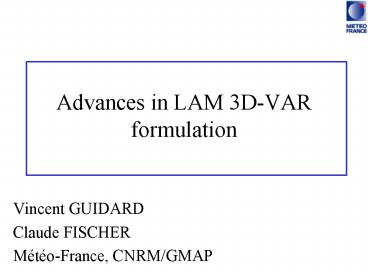Advances in LAM 3D-VAR formulation - PowerPoint PPT Presentation
Title:
Advances in LAM 3D-VAR formulation
Description:
Through various experiments, a drawback of biperiodic increments has arisen : ... Aim: comparing DA and BK. comparing BO and BOK. 2.2 Large scale update - evaluation ... – PowerPoint PPT presentation
Number of Views:40
Avg rating:3.0/5.0
Title: Advances in LAM 3D-VAR formulation
1
Advances in LAM 3D-VAR formulation
- Vincent GUIDARD
- Claude FISCHER
- Météo-France, CNRM/GMAP
2
Introduction
- Through various experiments, a drawback of
biperiodic increments has arisen wrapping
around analysis increments
3
Introduction
4
Introduction
- Through various experiments, a drawback of
biperiodic increments has arisen wrapping
around analysis increments? Controlling the
lengthscale of the correlation functions is
necessary compact support - Introduction of a large-scale information in the
LAM analysis to let the increments due to the
observations be of mesoscale
5
1.1 Compact support - definition
- Aim Reducing the lengthscale of structure
functions - The COmpactly SUpported (COSU) correlation
functions are obtained through a gridpoint
multiplication by a cosine-shape mask
function.The mask should be applied to the
square root of the gridpoint correlations
(Gaspari and Cohn, 1999)
6
1.1 Compact support - definition
- Steps to modify the power spectrum
- Power spectrum modal variances
- Fill a 2D spectral array from the 1D square root
of the modal variances - Inverse bi-Fourier transform mask the gridpoint
structure direct bi-Fourier transform - Collect isotropically and square to obtain
modified modal variances - Modal variances power spectrum
7
1.2 Compact support 1D model
Gridpoint Auto- Correlations T 22
8
1.2 Compact support 1D model
Power Spectrum T 22
9
1.2 Compact support 1D model
Analysis
10
1.3 Compact support ALADIN
- Univariate approach
Horizontal covariances COSU 100km-300km
Original B
11
1.3 Compact support ALADIN
- Multivariate approach
- The multivariate formulation (Berre,
2000)u is the umbalanced part of the
errorH is the horizontal balance operator
12
1.3 Compact support ALADIN
- COSU Horizontal autocorrelations Vertical
cross-correlations and horizontal balance
operator not modified - Whatever the distance of zeroing, results are
worse than with the original B. - Explanation the main part of the (temperature)
increment is balanced, while only the horizontal
correlations for z are COSU, but not for Hz.
13
1.3 Compact support ALADIN
- Cure 1 a modification of the z power spectrum
in order to have COSU correlations for Hz ? same
results as the original B. - Cure 2 another solution is to compactly support
the horizontal balance operator
14
1.3 Compact support ALADIN
15
1.3 Compact support conclusion
- Single observation
- Very efficient technique in univariate case
- Needs drastic measures (COSU horizontal balance)
to be efficient in multivariate case - Full observation set
- No impact, even with drastic measures
- Further research is necessary
- Problems possibly due to a large scale error
which this mesoscale analysis tries to reduce ?
use of another source of information for large
scales
16
2.1 Large scale cost-function
- Aim input a large scale information in the LAM
3D-VAR. - The large scale information is the analysis of
the global model (ARPEGE) put to a LAM low
resolution geometry - Thanks to classical hypotheses, plus assuming
that the global analysis error and the LAM
background error are NOT correlated, we simply
add a new term to the cost function
17
2.1 Large scale cost-function
- J(x) Jb(x) Jo(x) Jk(x), where
- H1 global ? LAM low resolutionH2 LAM
high resolution ? LAM low res. V large
scale error covariancesxAA global analysis
18
2.2 Large scale update - evaluation
- 1D Shallow Water global model (I. Gospodinov)
LAM version with Davies coupling (P.
Termonia)Both spectral models - 1D gridpoint analyses implemented
- Using LAM background and observation (JbJo)? BO
- Using LAM background and global analysis (JbJk)
? BK - Using all information (Jb JoJk) ? BOKPlus
dynamical adaptation ? DA - Aim comparing DA and BK comparing BO and BOK
19
2.2 Large scale update - evaluation
- Dynamical Adaptation versus BK
Statistically (Fisher and Student tests on bias
and RMS) No difference between DA and BK
LAM background
BK analysis
DA
global analysis
truth
20
2.2 Large scale update - evaluation
- BO versus BOK observation over all the domain
Statistically No difference between BO and BOK
LAM background
BOK analysis
BO analysis
global analysis
truth
observation
21
2.2 Large scale update - evaluation
- BO versus BOK obs. over a part of the domain
Statistically BOK better than BO
LAM background
BOK analysis
BO analysis
global analysis
truth
observation
22
2.3 Large scale update - conclusion
- The large scale information seems useful only in
border-line cases, in the Shallow Water model - Next steps
- Evaluation in a Burger model
- Ensemble evaluation of the statistics in
ARPEGE-ALADIN (based on the work of Loïk Berre,
Margarida Belo-Pereira and Simona Stefanescu) - Implementation in ALADIN































